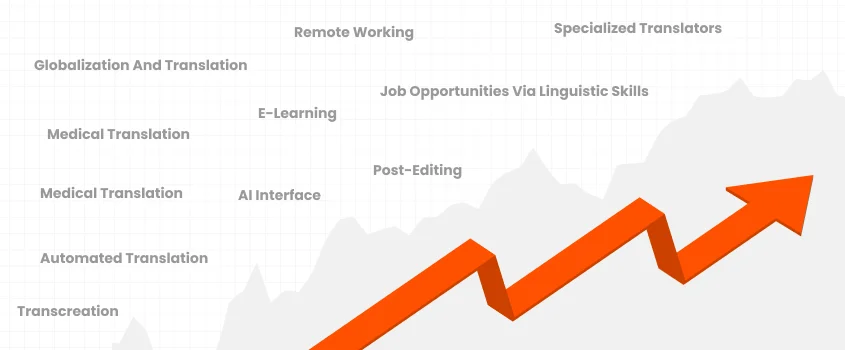Top 11 Growth Boosting Trends in the Translation Industry
By: Admin Posted on Mon, 04-10-2021

If you are an avid internet user (which you most probably are, you must be aware of the popular myth of English as lingua franca online. For businesses in the West, it may be true. But since most internet users are bilingual, things are a bit trickier. The unpredictability of the past year has highlighted one phenomenal aspect for the internet users (and businesses) i.e., language is key to communicate. Whether it’s B2B or B2C, translation has become more vital than ever.
Because pandemic threw a curveball our way, the world shifted online in a literal way. The translation is constantly evolving and changing. It cannot rest easy. Due to the sudden shift of online traffic, things turned in the favor of translation.
Thankfully for translators and bilingual readers, this is not a surprise.
In this article, we will cover most growth-boosting trends adopted by the companies, proving that translation survives even through the worst economic conditions.
Top 11 Trends in the translation industry so far to Look at:
As we have hinted earlier, translation is constantly changing. As one of the most technology-driven industries, the digital age is clarifying the use and importance of quality content - be it social media or products, language is crucial either way.
The new technologies are shaping the use of translators and interpreters around the world. How? Let’s find out.
1. Globalization and Translation
Globalization has resolved the political barriers as well as geographical barriers. To imagine a business reaching a German audience is possible thanks to the internet and the translators working at the backend.
Translators and interpreters aid in communication by providing error-free documents, product descriptions, websites, articles, and whatnot. The worldwide connections are now part of these organizations. So it’s not a surprise that corporations are surviving only because they have decided to go local.
The new analytical insights show that two-thirds of the global population will have internet access in the future. So providing the information in the local language is only going to be helpful.
2. Remote Working
The first and foremost change people had to adopt was working from home. Remote work is not everyone’s cup of tea. However, due to COVID-19, circumstances said otherwise. But this also meant that online communication vastly took hold too.
Online communication via video calls or something as simple as document sharing (like reports etc.) has always been critical in the healthcare industry.
The trend is not slowing down, but with each passing month, the use of online protocols will only increase. Since the pandemic, health sectors are scrutinizing the importance of remote arrangements. Fortunately, interpretation and live translation is making things easier, benefiting the pharmaceuticals and other healthcare departments. Besides healthcare, some of the other industries like e-learning are flourishing due to avid translations.
3. Podcast and Vlogging
Online blogging was one of the fastest trends that hit YouTube. Since users are moving online a lot for reviews, discussions, content creation, etc. the use of the internet grew tremendously. 82% of the global traffic is bound to increase by 2022 thanks to the bloggers influencing people all over the world.
It doesn’t matter which language you speak, YouTube provides automated subtitles so, it’s a win-win. Besides, video translation is now a thriving market (just recall all the dubbed movies a long time ago!).
Podcasts are viral these days, too. The advanced system of two individuals talking over grueling trends is another popular trend driving the translation industry to the top of the ladder. Multilingual podcasts are advancing among the biggest operators.
4. E-learning
Educational institutions shut down during the pandemic had to face a sudden shift in their teaching norms. Say hello to e-learning. The fact that the e-learning industry is said to be worth $355 billion in 2025, means that even in dire conditions, teachers could teach classes. The concept of e-learning evolved dramatically with language translation.
For instance e-books, available in multilingual audios, are available on Amazon and various learning platforms.
Online learning is significant growth for the translation market. E-tools and materials are made available in several languages.
5. Medical Translation
As we have mentioned about the healthcare industry above, let’s focus on the fact that a diverse population means interacting with more than one language.
The struggle to share knowledge in a fast turnaround time is real. Due to the rapid use of technology, the public is now aware of details that used to be lost due to language differences. Governments now want the public to take the right precautions and in whichever language is necessary, the information must be delivered.
Due to the healthcare crisis going on, medical translation is unavoidable
6. Job Opportunities via Linguistic Skills
Translators and interpreters are talented individuals and professionals. They are brimming more and more since remote work became bread earning for many. Language skills are yet another way to survive the lack of proper jobs. If you thought language couldn’t become your reason for earning, think again.
People who can speak trending languages like Chinese, German, Japanese, Portuguese, etc. have immense opportunities to find jobs as professional translators and interpreters. Also, other industries like life sciences and software development are always in need of linguistic experts to localize a quality product or service.
7. AI Interface
Hybrid translation has been questionable in the past. With the advanced artificial intelligence currently, it is predicted that machine translation may take over human translation. We are not quite there yet, but tools are a means of progress. Google Translate, among other machine translation tools, is a great example, to begin with.
The new hybrid platforms for translation are improving quality and the entire process in the language industry. The use of CAT tools is yet another primary example. So the deep neural networks and translation are now becoming the future.
8. Automated Translation
Automation is much needed these days. Automated translation is the basic version of what an updated neural translation looks like.
Due to technologies like machine translation, the surge in translation memory and glossaries is obvious. This means that translators can focus on the projects without worrying about the next word in the content. The translation memory or glossaries can suggest words in the desired target language.
Especially in repetitive tasks, translation memory comes handy to automate translation. It is absolutely helpful in long-term projects in the same language pair.
9. Transcreation
Branding with transcreation is the next best thing after machine translation. Brands that continue to enter new markets are fighting nail and tooth to gain the upper hand. It can be made possible for them by focusing on enhancing the personalized experiences.
Transcreation becomes necessary when a brand with the intent to brand the slogan, marketing copy, images, etc., wants to be culturally appropriate for the audience.
So translation is not enough in marketing and advertising, you need to be able to reach the emotional side of the audience which is made possible with transcreation.
10. Post-editing
Artificial intelligence helped improve the quality and accuracy of the translation process. Therefore, the already existing content online can also be translated into a better quality version. More than 78% of the websites use LSP (language service provider) so that the predicted use of machine translation has shown an increase of 19%.
Since humans are still more sound options, the editing and proofreading are conducted in a series of steps. Of course, the use of technological tools still exists, however, to communicate in a better way, it is important to ensure that the content is accurate for the consumer. So instead of relying blindly on technology, post-editing is a necessary call.
11. Specialized Translators
The two head competitors of all time are IT and life sciences. Both industries evolve quickly and believe in rapid development. Therefore, both industries are heavily invested in specialized terminologies that a subject-matter expert can handle.
The level of experience and knowledge under their belt make it important to hire a specialized translator. Even during the manufacturing of a domestic product, translators are working on multilingual product labeling. That way, legal translation is growing at a rapid pace, too.
Bottom Line:
Trends in the translation industry revolve around the predecessor technologies. Therefore, it is easier for the translation if you hire professional translation services with various subject-matter experts.
Their translation management interface will be automated with translation needs as per clients’ demands. So you can either get a quote now or contact us for further assistance.

There is no such thing as a perfect business idea. But there’s always that one idea that hits the bull’s
Read more
In this age of digitalization, many global companies and the companies that are emerging on the global landscape are using
Read more
Austin is the capital city of the US state of Texas. It is the 11th most populous city in the
Read more
With the ever-changing technological landscape, few things have grown as exponentially as games. As more game manufacturing companies seek to
Read more
Language is that unique tool that distinguishes mankind from any other creature. Human beings always intend to understand each other’s
Read more
In this digital world, you can show your emotions to others with the help of emojis. The word emoji is
Read more
With the advent of globalization and digitization, language connectivity has become very important. For multilingual connectivity, localization platforms have shared
Read more
We are living in a fast-paced world. Sometimes we don’t get time to go out and shop from brick-and-mortar stores.
Read more
Every company wants to expand its business outside the borders. For this, they have to open their subsidiaries and offices
Read more